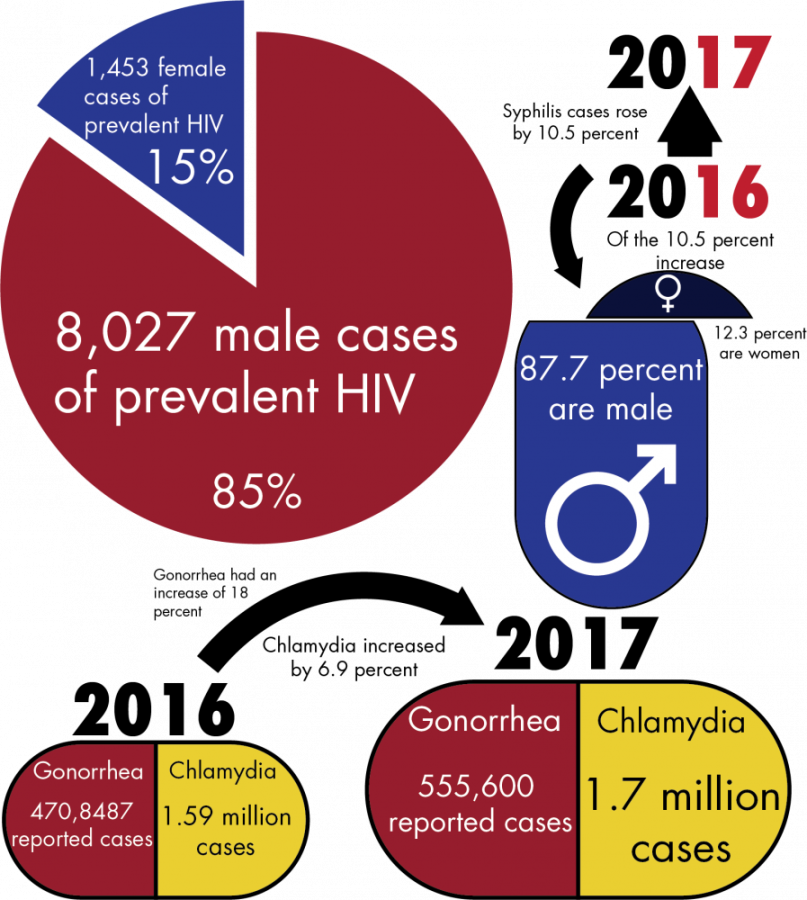Students at risk of being exposed to HIV can turn to the University of Arizona Campus Health Service for a drug that helps protect against getting the virus.
The brand name is Truvada, and in 2012, it became the first drug approved by the U.S. Food and Drug Administration to reduce the risk of being infected by HIV, according to the FDA’s website.
Truvada is a combination of tenofovir disoproxil and emtricitabine and a form of pre-exposure prophylaxis, which is also known as PrEP.
Cesar Egurrola, lead clinical coordinator at the UA Department of Medicine’s Petersen HIV Clinic, said when a PrEP medication is taken daily by HIV-negative patients, it prevents the transmission of HIV.
“Daily adherence to PrEP is essential to prevent HIV infection,” Egurrola said.
Patients who use PrEP must also undergo routine HIV and STD screenings and regularly visit their PrEP provider while on the medication, Egurrola said.
There is a similar method of using medication, called post-exposure prophylaxis or PEP, which helps prevent HIV transmission after a person is exposed to it.
Egurrola said PEP is most often used after someone may have been exposed to HIV through sexual contact, sexual assault or from exposure to blood, often through needles.
“If PrEP can be compared to ‘the pill,’ PEP could be compared to ‘Plan B,’ with the exception that, for PEP, the 28-days course of treatment needs to be completed,” Egurrola said. “And there is no weight maximum for PEP efficacy.”
Dr. Kathy Wilson, a physician at Campus Health, said that in addition to taking PEP for 28 days, the medication must be started within 72 hours of the possible HIV exposure to be effective. She said following the dosage instructions for both PrEP and PEP is vital.
“Both regimens need to be taken daily to provide maximal effectiveness,” Wilson said. “When taken daily, PrEP has a 92 percent success rate in the prevention of HIV transmission. Per the CDC, PEP is very effective in the prevention of transmission of HIV, but not 100 percent.”
STDs on the rise
Lee Ann Hamilton, the assistant director of Health Promotion and Preventive Services at Campus Health, said students taking PrEP and PEP should be advised the medications do not protect against other sexually transmitted diseases. She said this is important to know because cases of STDs are being seen more frequently lately.
RELATED: The rise of STDs and the role of online dating apps: Misconceptions behind online ‘hookup culture’
“PreP and PEP only protect against HIV,” Hamilton said. “We continue to see high rates of chlamydia and have seen more syphilis than in past years.”
According to the most recent Sexually Transmitted Disease Surveillance report by the Centers for Disease Control and Prevention in 2017, rates of STDs have been increasing across the country.
The report showed that over 1.7 million cases of chlamydia in the U.S. were reported in 2017, an increase of 6.9 percent from the previous year. Reported cases of gonorrhea totaled over 555,600, which was over an 18 percent increase from 2016 and an increase of a little over 75 percent from a record low in 2009.
The CDC report showed rates of syphilis rose 10.5 percent from 2016 to 2017, and 87.7 percent of those reported cases were men.
Men make up the majority of people in Arizona who have HIV, according to the 2018 Arizona HIV/AIDS Epidemiology Supplemental Report from the Arizona Department of Health Services.
The report showed that out of the estimated 9,480 cases of prevalent HIV in the state in 2017, 8,027 cases were male.
Egurrola said the main demographic that uses PrEP is “mostly men who have sex with men, predominantly white, followed by Hispanic.”
RELATED: Conversation on HIV/AIDS reveals lack of understanding among some students
Wilson said more UA students and Tucsonans are becoming aware of these medications through community outreach such as the PrEP and PEP Navigators program by the Southern Arizona AIDS Foundation.
“Word of mouth is an effective tool to encourage our students to come in to Campus Health to start PrEP and PEP, or even simply to ask questions, allowing them to become better informed about their options,” Wilson said.
Wilson said students have the opportunity to get the medications at reduced prices, and some are even able to get them without paying out-of-pocket.
“There are patient-assistance programs and grants available that can offset the price of the medications,” Wilson said. “We utilize pharmacies that are well-versed in navigating these programs in order to provide our students with the lowest cost possible, regardless of insurance coverage or lack thereof.”
Students who are interested in PrEP and PEP can schedule appointments with PrEP/PEP providers at Campus Health to find out more or reach out to SAAF through its Navigators program.
Follow Jesse Tellez on Twitter









